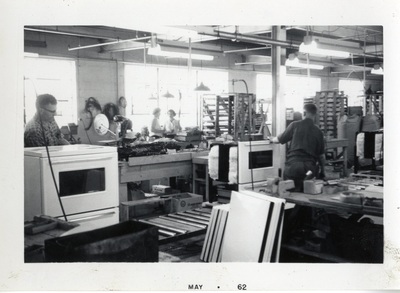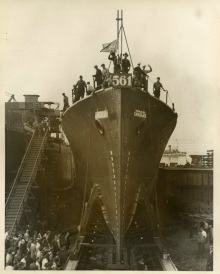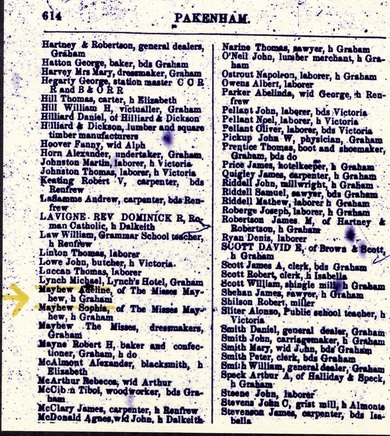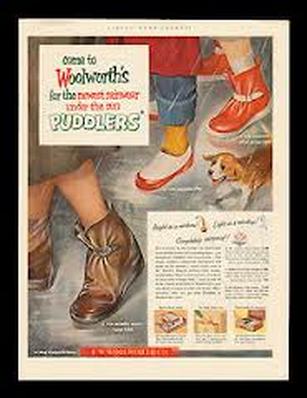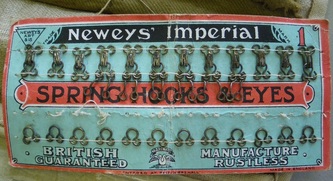Our Collection:
Our Mandate is to collect, preserve and share items that are significant to the history of
Carleton Place and to Beckwith Township. Our Museum now houses over 10,000 artifacts!
These include three-dimensional objects, textiles, photographs, and archival documents.
All of these artifacts have been generously donated to the museum by individuals in the community.
Thank you!
Our environmentally-controlled Collections Storage Area contains all items not currently on display.
All items are catalogued into our database, enabling staff and volunteers to easily locate objects.
Our Mandate is to collect, preserve and share items that are significant to the history of
Carleton Place and to Beckwith Township. Our Museum now houses over 10,000 artifacts!
These include three-dimensional objects, textiles, photographs, and archival documents.
All of these artifacts have been generously donated to the museum by individuals in the community.
Thank you!
Our environmentally-controlled Collections Storage Area contains all items not currently on display.
All items are catalogued into our database, enabling staff and volunteers to easily locate objects.
Featured Photos:
Please visit our Flicker site to see more photos from our collection: www.flickr.com/people/182466350@N02/?fbclid=IwAR0-wGzuzJgD05r6wpA92auab-_FMT4sYOamLz9S-qHM2mcCK8sYjgVxeJk
Featured Artifacts:
Straw Splitter
(2005.283.15)
Straw Splitter
(2005.283.15)

This is a "straw splitter", used to split lengths of straw into thin strips which were then used in the making of braided straw hats. Obviously home-made, this object has a card tag attached to it with "A Straw splitter, made by the late Hugh Aukland out of a penny, over 60 years ago."
This tag would have been written in 1896, when the straw splitter was put on display at the Historic Heirloom Show at the Opera House in Carleton Place.
The following description of the event is from Founded Upon A Rock, Carleton Place Recollections, by Howard Morton Brown:
"An amazing wealth of hundreds of prized heirlooms of historic and social interest owned by Lanark and Renfrew district families was collected by a dozen committees composed of over fifty well known Carleton Place residents, for a week's showing in the Opera Hall. Mementos of events in the early history of Lanark County were especially and successfully sought, together with old family possessions brought from Scotland, Ireland and England, and from the United Staes during or after the American Revolution. Chief classes were china and stoneware, pictures, wearing apparel, books and documents, agricultural and household implements and equipment, weapons, jewelry;; silver, brass, pewter and plated ware; musical instruments, Indian ornamented possessions, collections of disinterred Indian stone artifacts, locally mounted fish, birds and animals; and coins and medals"
This tag would have been written in 1896, when the straw splitter was put on display at the Historic Heirloom Show at the Opera House in Carleton Place.
The following description of the event is from Founded Upon A Rock, Carleton Place Recollections, by Howard Morton Brown:
"An amazing wealth of hundreds of prized heirlooms of historic and social interest owned by Lanark and Renfrew district families was collected by a dozen committees composed of over fifty well known Carleton Place residents, for a week's showing in the Opera Hall. Mementos of events in the early history of Lanark County were especially and successfully sought, together with old family possessions brought from Scotland, Ireland and England, and from the United Staes during or after the American Revolution. Chief classes were china and stoneware, pictures, wearing apparel, books and documents, agricultural and household implements and equipment, weapons, jewelry;; silver, brass, pewter and plated ware; musical instruments, Indian ornamented possessions, collections of disinterred Indian stone artifacts, locally mounted fish, birds and animals; and coins and medals"

Funeral Notice
(1994.13.3)
This black bordered card was printed to inform the public of the death of Dr. Richard F. Preston.
Dr. Preston operated his medical practise in Carleton Place from 1887 until his death. Dr Preston also acted as Reeve of Carleton Place (1884-1866), the first Mayor of Carleton Place (1890 - 1892), a member of the Legislative Assembly (1895) and Member of Parliament in the 1920s.
(1994.13.3)
This black bordered card was printed to inform the public of the death of Dr. Richard F. Preston.
Dr. Preston operated his medical practise in Carleton Place from 1887 until his death. Dr Preston also acted as Reeve of Carleton Place (1884-1866), the first Mayor of Carleton Place (1890 - 1892), a member of the Legislative Assembly (1895) and Member of Parliament in the 1920s.
Dr. Preston's office was located at 104 Bridge Street.
The property was originally owned by Edmund Morphy. Later owners include James McDiarmid, Allan McDonald, John McEwen, Archibald Gillies and Alexander Forbes Stewart. Stewart sold the property to Dr. Richard F. Preston in 1883 for $1,000. This site was listed as "vacant" in town assessment roles of 1885 - 1889. From 1890 - 1897 it was listed as "unfinished".
The home originally had a stable behind it, kept by a Mr. Halpenny who drove the buggy for the doctor.
The property was originally owned by Edmund Morphy. Later owners include James McDiarmid, Allan McDonald, John McEwen, Archibald Gillies and Alexander Forbes Stewart. Stewart sold the property to Dr. Richard F. Preston in 1883 for $1,000. This site was listed as "vacant" in town assessment roles of 1885 - 1889. From 1890 - 1897 it was listed as "unfinished".
The home originally had a stable behind it, kept by a Mr. Halpenny who drove the buggy for the doctor.

Matchbook Cover
(2015.1.1)
This matchbook was a give away from the Olympia Restaurant in Carleton Place. Located at 101 Bridge Street, the restaurant, with its booths, curved counter and red leather stools, was a local institution. First opened by Louis and James Laskaris as the Olympic Candy Store in 1920, it was later sold to Jim Antonakos in 1958.
A fire destroyed the building in 1960, but it was rebuilt and opened again in 1961.
The Olympia closed it's doors for good in 2000 and is still greatly missed.
(2015.1.1)
This matchbook was a give away from the Olympia Restaurant in Carleton Place. Located at 101 Bridge Street, the restaurant, with its booths, curved counter and red leather stools, was a local institution. First opened by Louis and James Laskaris as the Olympic Candy Store in 1920, it was later sold to Jim Antonakos in 1958.
A fire destroyed the building in 1960, but it was rebuilt and opened again in 1961.
The Olympia closed it's doors for good in 2000 and is still greatly missed.

Decoy
(1986.16.4)
This wooden duck decoy was carved by Nathan McCallum. Nathan Dayton McCallum was born in Lanark Village in 1862. He moved to Carleton Place in 1868 with his parents Thomas and Margaret.
Nathan worked as a clerk and as a lumber inspector (1891 census) for Caldwell Lumber Mills, located at Riverside Park. Later, for many years, he was the head bookkeeper for Horace Brown and Sons Flour Mill.
Nathan and his wife Sarah lived in the frame house on Lake Avenue West at the north-east corner of Hawthorne Street. He gave this and several other decoys to Howard Morton Brown, youngest son of Morton, in 1920. Howard generously donated the collection to The Carleton Place and Beckwith Heritage Museum in 1986.
(1986.16.4)
This wooden duck decoy was carved by Nathan McCallum. Nathan Dayton McCallum was born in Lanark Village in 1862. He moved to Carleton Place in 1868 with his parents Thomas and Margaret.
Nathan worked as a clerk and as a lumber inspector (1891 census) for Caldwell Lumber Mills, located at Riverside Park. Later, for many years, he was the head bookkeeper for Horace Brown and Sons Flour Mill.
Nathan and his wife Sarah lived in the frame house on Lake Avenue West at the north-east corner of Hawthorne Street. He gave this and several other decoys to Howard Morton Brown, youngest son of Morton, in 1920. Howard generously donated the collection to The Carleton Place and Beckwith Heritage Museum in 1986.
|
Memorandum Book
(2005.283.16d) The first electric lights were introduced to Carleton Place in 1885. This small orange notebook labelled "Memo, Electric Light Co., List of Users, etc. etc, and Notes "by the way"" was kept by W.A. Braedon. On the first page he has written: "Memo of parties using the Electric Light and date when they got the Light in Carleton Place". His list begins September 28th, 1885. Homeowners were charged by the number of bulbs and the number of hours the bulb was turned on. |
|
Old Home Week Souvenir Programme
(1983.2.1) This booklet, measuring 23x15cm, was created for the Centenary Celebration and Old Home Week of Carleton Place from August 3rd to August 9th, 1924. Although the town had settled in 1819, there were months of planning and preparation for the return of the town’s young and old boys and girls from distant and nearby points. The week began with the ringing of church bells and the sounding of the whistles or bells of the railway shops, of Findlay Brothers foundry and of the Bates & Innes and Hawthorne woollen mills. The Carleton Place and Beckwith Heritage Museum loves this Souvenir Programme! It provides us with timeless images of Carleton Place, past Mayors from 1890-1924 and numerous old advertisements for local businesses. It also describes some of the events during that week 90 years ago: such as Decoration Day, baseball games, a Merry-Go-Round, Dog and Pony Shows, street dancing, Fancy Shooting at the Gun Club, and countless more activities. |

Bottle Fragment
(1993.29.2)
Yes, this is top of a broken bottle! To be specific, this is the neck of the champagne bottle used by Hilda Morris to Christen the H.M.C.S.Carlplace on July 6th 1944. With red, white and blue ribbons attached to the end, and remnants of gold foil adhered to the glass, it measures 25cm long.
The H.M.C.S. Carlplace was a river class frigate commissioned by the Royal Canadian Navy in 1944. It was adopted by the Town of Carleton Place, with funds being raised by the municipality to provide comforts for the ship's crew. The "Carlplace Comforts Committee" supplied a bicycle, typewriters, cameras and draperies to the ship,, and the Carleton Place I.O.D.E. made fur lined seamen's jackets for all the crew members.
The Carlplace was launched at Lauzon, Quebec on July 6, 1944. Hilda Morris, wife of Carleton Place Mayor Mervyn Morris, had the honour of performing the Christening of the Ship. (See photo at right below showing the bottle stuck on the prow of the ship!) Other Carleton Place residents attending the ceremony included Reeve and Mrs. W. Asa Roe, Deputy reeve Bill Prime, Councillor and Mrs. Earl Dunlop, Councillor and Mrs. Horace Sedman, Councillor and Mrs. Harry Crawford, Mr. and Mrs. George Healey, and Mr. Dan Nichols.
When the ship was decommissioned in November of 1945, the Ship's bell was donated to The Town of Carleton Place. It and many other artifacts are on display in the Town Hall lobby this summer, to commemorate the 70th Anniversary of the Ship's Launching.

Tent Peg
(1986.19.70)
This carved wooden tent peg measures 44 x 4 cm. One end has a curved notch and the other end is tapered. Tent pegs are used to help maintain the tent's shape, and to hold the tent in place against wind. They are usually inserted into the ground by hand, but depending on the ground or how large the peg is, a mallet could also drive them into the ground.
This peg was used at the Brown family camp at Lake Park on Mississippi Lake. Horace Brown had purchased land at Lake Park in 1893. The family camped in canvas tents each summer until their frame cottage “Orkney” was built in 1913.
The family was well-known locally for the establishment of electricity in Carleton Place and Beckwith, as well as the operation and expansion of a large grist mill on the edge of the Mississippi River. A celebrated member from this family was A. Roy Brown, a WWI fighter pilot credited with shooting down the Red Baron.

Coffin Plate
(1988.28.166)
This rectangular metal plate measures 19 x 11 cm. It was engraved to be placed on the coffin of Mary Adeline Mayhew (1838 - 1903). Coffin plates were affixed to the lid of a coffin for the duration of a visitation, wake or funeral. The plate was removed prior to burial and given to the family as a keepsake.
Adeline, as she was known, was a local dress maker and milliner in the late 1800's. The Pakenham Business Directory of 1875 lists "The Misses Mayhew" shop run by Sophia and her sister Adeline on Graham Street.
(1988.28.166)
This rectangular metal plate measures 19 x 11 cm. It was engraved to be placed on the coffin of Mary Adeline Mayhew (1838 - 1903). Coffin plates were affixed to the lid of a coffin for the duration of a visitation, wake or funeral. The plate was removed prior to burial and given to the family as a keepsake.
Adeline, as she was known, was a local dress maker and milliner in the late 1800's. The Pakenham Business Directory of 1875 lists "The Misses Mayhew" shop run by Sophia and her sister Adeline on Graham Street.
In 1879 the sisters moved to Carleton Place and set up shop on Bridge Street, as noted in the Carleton Place Directory listing: "Mayhew, Miss Adeline (S. & A. Mayhew)".
Sophia died in 1887, but Adeline,along with her sister Bertha, continued to run themillinery shop until 1900. Adeline lived with Bertha, her husband Henry Schwerdtfeger and their two daughters at their home on Lake Avenue West until her death. Many of her personal belongings and hat making supplies are in the collection of the Carleton Place and Beckwith Museum and were on display in our "Brimful of Memories" exhibit.
Sophia died in 1887, but Adeline,along with her sister Bertha, continued to run themillinery shop until 1900. Adeline lived with Bertha, her husband Henry Schwerdtfeger and their two daughters at their home on Lake Avenue West until her death. Many of her personal belongings and hat making supplies are in the collection of the Carleton Place and Beckwith Museum and were on display in our "Brimful of Memories" exhibit.

Rain Boots
(2007.20.2)
Get ready for April showers with these "Deluxe Puddlers".
These ladies' rain boots are size 13 and the colour was known as "smoke".
Puddlers were made of "exclusive long wearing polylastic" which was a very stretchy, waterproof rubber. Polylastic was originally produced by Concord Rubber Limited in Lachine, Quebec. These boots are indeed, very light and the rubber is almost see-through and quite soft and stretchy.
(2007.20.2)
Get ready for April showers with these "Deluxe Puddlers".
These ladies' rain boots are size 13 and the colour was known as "smoke".
Puddlers were made of "exclusive long wearing polylastic" which was a very stretchy, waterproof rubber. Polylastic was originally produced by Concord Rubber Limited in Lachine, Quebec. These boots are indeed, very light and the rubber is almost see-through and quite soft and stretchy.

Invitation
(1994.17.12b)
"Come to the Irish Tea"!
Mabel Hooper sent this Irish clover shaped invitation to her neighbour Bertha Schwerdtfeger, inviting her to a Ladies Aid tea. Mabel was married to decorated war hero Captain William Henry Vickers Hooper, and lived at the corner of Bridge Street and Lake Avenue.
Her husband had served in the Boer War and later moved to Carleton Place where he worked as a photographer. During WWI he led the first contingent of Carleton Place men overseas. In April 1915 Hooper was wounded and captured by the Germans and spent a year and a half as a prisoner of war in Mainz, Germany. Upon his return home he worked as Postmaster from 1919 to 1950 and served as Mayor of Carleton Place in 1923.
Invitation
(1994.17.12b)
"Come to the Irish Tea"!
Mabel Hooper sent this Irish clover shaped invitation to her neighbour Bertha Schwerdtfeger, inviting her to a Ladies Aid tea. Mabel was married to decorated war hero Captain William Henry Vickers Hooper, and lived at the corner of Bridge Street and Lake Avenue.
Her husband had served in the Boer War and later moved to Carleton Place where he worked as a photographer. During WWI he led the first contingent of Carleton Place men overseas. In April 1915 Hooper was wounded and captured by the Germans and spent a year and a half as a prisoner of war in Mainz, Germany. Upon his return home he worked as Postmaster from 1919 to 1950 and served as Mayor of Carleton Place in 1923.
Lunchbox
(2007.107.1)
February is the month of love! What better way to say "I love you" than with a handwritten note in permanent ink! Verna MacFarlane packed up a lunch every morning in this tin lunchbox for her husband Erwin, who worked for the CPR in Carleton Place. One day she sent him a message in red marker, written on the inside sliding lid of Erwin's blue lunchbox.
"Verna loves Erwin...My perfect husband xxx xxx".
(2007.107.1)
February is the month of love! What better way to say "I love you" than with a handwritten note in permanent ink! Verna MacFarlane packed up a lunch every morning in this tin lunchbox for her husband Erwin, who worked for the CPR in Carleton Place. One day she sent him a message in red marker, written on the inside sliding lid of Erwin's blue lunchbox.
"Verna loves Erwin...My perfect husband xxx xxx".

1922 Calendar
(2013.20.36)
A new calendar is a fresh start on a new year! This large (56cm x 74cm) paper calendar was produced for Bates & Innes Limited, Carleton Place, for the year 1922. Featuring a full colour illustration of a sheep auction by George E. Mcelroy of Montreal, this calendar was certainly used, for all tear-off monthly pages are gone except December.
Ron W. Bates and J.A. Innes took over the woolen mill built by Archibald McArthur in 1871. Located on a man made island in the Mississippi River in Carleton Place, this 4 story stone mill had several owners before they purchased it in 1907. It was built of rubble wall construction - with exterior and interior walls of one foot thick limestone blocks with another foot of gravel between. The turbine wheels are still visible today, mounted on free standing timbers outside the stone walls to prevent the end of the mill from being shaken and damaged.
Our calendar features several well known Bates and Innes logos - they were famous for their "OV Brand", (Ottawa Valley), "Pure Wool Underwear, Weight and Warmth for the Out-of-Doors Man".
It also advertises "Velvoknit - Distinguished for its Softness and Fineness".
During World War One, the firm was busy meeting military needs for blankets, underwear, cloth and knitted puttees. They were the first mill in Canada to use flat-lock seams on heavy rib combinations.
During the Second World War, the mill ran night and day in all departments, providing military blankets, underwear, puttees and and a long run on a 40 ounce knitted duffle cloth, with water proofing treatment that was used in naval pea jackets. The wheeling yarn department turned out tens of thousands of pounds of yarn for the Canadian Red Cross to be hand knit by the women of Canada into warm socks, mitts and sweaters for the men overseas.
Bates and Innes ceased operations in 1963, due, in part, to the introduction of synthetic fibres.
(2013.20.36)
A new calendar is a fresh start on a new year! This large (56cm x 74cm) paper calendar was produced for Bates & Innes Limited, Carleton Place, for the year 1922. Featuring a full colour illustration of a sheep auction by George E. Mcelroy of Montreal, this calendar was certainly used, for all tear-off monthly pages are gone except December.
Ron W. Bates and J.A. Innes took over the woolen mill built by Archibald McArthur in 1871. Located on a man made island in the Mississippi River in Carleton Place, this 4 story stone mill had several owners before they purchased it in 1907. It was built of rubble wall construction - with exterior and interior walls of one foot thick limestone blocks with another foot of gravel between. The turbine wheels are still visible today, mounted on free standing timbers outside the stone walls to prevent the end of the mill from being shaken and damaged.
Our calendar features several well known Bates and Innes logos - they were famous for their "OV Brand", (Ottawa Valley), "Pure Wool Underwear, Weight and Warmth for the Out-of-Doors Man".
It also advertises "Velvoknit - Distinguished for its Softness and Fineness".
During World War One, the firm was busy meeting military needs for blankets, underwear, cloth and knitted puttees. They were the first mill in Canada to use flat-lock seams on heavy rib combinations.
During the Second World War, the mill ran night and day in all departments, providing military blankets, underwear, puttees and and a long run on a 40 ounce knitted duffle cloth, with water proofing treatment that was used in naval pea jackets. The wheeling yarn department turned out tens of thousands of pounds of yarn for the Canadian Red Cross to be hand knit by the women of Canada into warm socks, mitts and sweaters for the men overseas.
Bates and Innes ceased operations in 1963, due, in part, to the introduction of synthetic fibres.

The Findlay Steamer
(2007.88.1)
After tasting plum pudding in a CPR dining car in 1940, Nora Findlay persuaded the chef to divulge his recipe, which she claimed, was a carefully kept company secret. David Findlay recalled "Mother used to lace the mix with large amounts of rum or brandy in addition to the bottle of stout. Guests always left the table in a happy mood!"
Nora passed the recipe on to her granddaughter Janet. The pudding should be made before the end of November, but Mrs. Findlay always maintained that the best ones were made on "All Saints' Day", November 1st.
(2007.88.1)
After tasting plum pudding in a CPR dining car in 1940, Nora Findlay persuaded the chef to divulge his recipe, which she claimed, was a carefully kept company secret. David Findlay recalled "Mother used to lace the mix with large amounts of rum or brandy in addition to the bottle of stout. Guests always left the table in a happy mood!"
Nora passed the recipe on to her granddaughter Janet. The pudding should be made before the end of November, but Mrs. Findlay always maintained that the best ones were made on "All Saints' Day", November 1st.

Findlay reunion, Christmas 1929.
A reunion of 31 descendants of Findlay's Limited founder David Findlay. Every living member of the family was present except for Mrs. David Findlay, aged 93, and 4th generation David and Leigh Findlay.
Nora, Mrs. Hamilton Findlay, is the third woman from the left in the front row.

A WWI "Housewife"
(2008.282.8)
This roll-up sewing kit, known as a "Housewife", was issued to soldiers in World War One.
In Carleton Place, housewives were originally made by members of the Women’s Institute for the local lads going off to what would become known as "The Great War".
This housewife from our collection was carried by J. Horace Brown, who was one of the first twelve Carleton Place citizens to leave for war in August 1914. Horace survived the war but sadly died overseas from complications of influenza.
Made of water-repellent oilcloth (on the outside), Horace’s housewife contained buttons, needles, thread, wool yarn, and hooks and eyes. The numerous inner pouches would have allowed him to carry other small items, such as perhaps his tiny prayer book (also in our collection).
Rolled up, it measures approximately 5” x 3” x 1”.
(2008.282.8)
This roll-up sewing kit, known as a "Housewife", was issued to soldiers in World War One.
In Carleton Place, housewives were originally made by members of the Women’s Institute for the local lads going off to what would become known as "The Great War".
This housewife from our collection was carried by J. Horace Brown, who was one of the first twelve Carleton Place citizens to leave for war in August 1914. Horace survived the war but sadly died overseas from complications of influenza.
Made of water-repellent oilcloth (on the outside), Horace’s housewife contained buttons, needles, thread, wool yarn, and hooks and eyes. The numerous inner pouches would have allowed him to carry other small items, such as perhaps his tiny prayer book (also in our collection).
Rolled up, it measures approximately 5” x 3” x 1”.
Proudly powered by Weebly




















